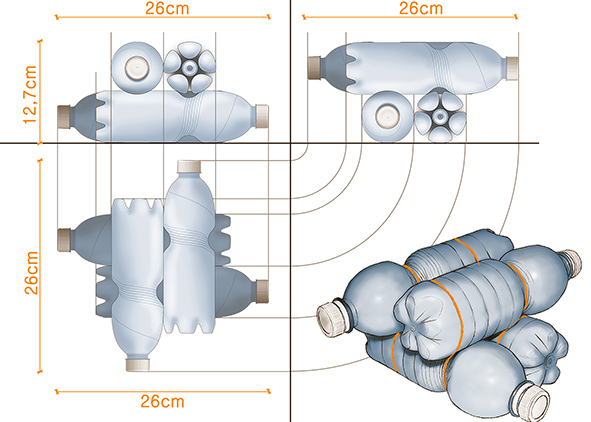Costruire con la Plastica. Una Nuova Possible Soluzione per l’Ambiente
DOI:
https://doi.org/10.19229/2464-9309/582019Parole chiave:
plastica, riciclo, bottiglie in PET, economia circolare, gestione dei rifiutiAbstract
La ricerca affronta il tema di un possibile riciclo delle bottiglie di plastica in edilizia come circuito addizionale di riuso. A seguito di una preliminare analisi critica di casi di studio per evidenziare le possibili variabili progettuali, si propone un metodo innovativo che usi la bottiglia di plastica per la realizzazione di murature a funzione portante. Sono stati progettati e realizzati modelli con diverse soluzioni costruttive fino alla proposta di un modulo composto da quattro bottiglie riempite di sabbia e legate tra loro. Test di compressione in laboratorio ha permesso di dimostrare la solidità del modulo di base e analisi f.e.m. di comprovare la stabilità della struttura. Questi primi risultati incoraggiano verso l’approfondimento di altre analisi e testimoniano una sua potenziale versatilità costruttiva ed esportabilità d’uso anche in contesti differenti sia a livello sociale, economico e ambientale.
Downloads
##plugins.generic.articleMetricsGraph.articlePageHeading##
Riferimenti bibliografici
Anyanka, U. (2011), Nigeria recycles plastic bottle, into housing! [Online] Available at: greennigeria.wordpress.com/2011/08/12 [Accessed 10 April 2019].
Campioli, A. and Lavagna, M. (2013), “Innovazione ambientale dei processi di trasformazione del costruito e ciclo di vita”, in Techne | Environment Emergency, vol. 5, pp. 66-73.
Chen, Q. et alii (2017), “Pollutants in Plastics within the North Pacific Subtropical Gyre”, in Environmental Science and Technology, vol. 52, n. 2, pp. 446-456. [Online] Available at: doi.org/10.1021/acs.est.7b04682 [Accessed 29 April 2019].
Chun, A. M. S. and Brisson, I. E. (2015), Ground Rules in Humanitarian Design, John Wiley & Sons, New Jersey.
Container Recycling Institute, Plastic Facts & Statistics. [Online] Available at: www.container-recycling.org/index.php/factsstatistics/plastic [Accessed 10 April 2019].
Ferrari, C. (2016), Progettare con le bottiglie di plastica – proposta per un padiglione a città del Messico, Master Degree Thesis in Engineering and Architecture, Università di Pavia.
Geyer, R., Jambeck, J. R. and Law, K. L. (2017), “Production, use and fate of all plastic ever made”, in Science Advances, vol. 3, n. 7, pp. 1-5. [Online] Available at: advances.sciencemag.org/content/3/7/e1700782 [Accessed 10 April 2019].
Kusimwiragi, K. (2011), Investigating the Compressive Strength of Plastic Bottles as Masonry, Uganda University. [Online] Available at: www.eco-tecnologia.com/phocadownload/descargas/k.kalumire_thesis.pdf [Accessed 29 April 2019].
Mansour, A. M. and Ali, S. A. (2015), “Reusing waste plastic bottle as an alternative sustainable building material”, in Energy for Sustainable Development, vol. 24, pp. 79-85.
Lebreton, L. C. M. et alii (2018), “Evidence that the Great Pacific Garbage Patch is rapidly accumulating plastic”, in Scientific Reports 8, article n. 4666. [Online] Available at: doi.org/10.1038/s41598-018-22939-w [Accessed 29 April 2019].
Plastics Europe (2018), Plastics: the facts 2018 – An analysis of European plastics production, demand and waste data. [Online] Available at: issuu.com/plasticseuropeebook/docs/plastics_the_facts_2018-_afweb [Accessed 29/04/2019].
Ruiz Valencia, D., Lopez Perez, C., Cortes, E. and Froese, A. (2012), “Nuevas alternativas el la construcion: botellas PET con relleno de tierra”, in Apuntes – Revista de Estudio sobre Patrimonio Cultural-Juornal of Cultural Heritage Studies, vol. 25, issue 2, pp. 292-303.
Sadat-Shojai, M. and Bakhshandeh, G. R. (2011), “Recycling of PVC wastes”, in Polymer Degradation and Stability, vol. 96, pp. 404-415.
Sharma, H. (2017), “Innovative and Sustainable Application of PET Bottle a Green Construction Overview”, in Indian Journal of Science and Technology, vol. 10, issue 16, pp. 1-6.
Taaffe, J., O’Sullivan, S., Rahman, M. E. and Pakrashi, V. (2014), “Experimental characterization of Polyethylene Terephthalate (PET) bottle Eco-bricks”, in Materials & Design, vol. 60, pp. 50-56.
World Economic Forum, Ellen Mac Arthur Foundation and Mc Kinsey Company (2016), The New Plastic Economy – Rethinking the future of plastic. [Online] Available at: www.ellenmacarthurfoundation.org [Accessed 14 February 2019].

##submission.downloads##
Pubblicato
Come citare
Fascicolo
Sezione
Licenza
AGATHÓN è pubblicata sotto la licenza Creative Commons Attribution License 4.0 (CC-BY).
License scheme | Legal code
Questa licenza consente a chiunque di:
Condividere: riprodurre, distribuire, comunicare al pubblico, esporre in pubblico, rappresentare, eseguire e recitare questo materiale con qualsiasi mezzo e formato.
Modificare: remixare, trasformare il materiale e basarti su di esso per le tue opere per qualsiasi fine, anche commerciale.
Alle seguenti condizioni
Attribuzione: si deve riconoscere una menzione di paternità adeguata, fornire un link alla licenza e indicare se sono state effettuate delle modifiche; si può fare ciò in qualsiasi maniera ragionevole possibile, ma non con modalità tali da suggerire che il licenziante avalli l'utilizzatore o l'utilizzo del suo materiale.
Divieto di restrizioni aggiuntive: non si possono applicare termini legali o misure tecnologiche che impongano ad altri soggetti dei vincoli giuridici su quanto la licenza consente di fare.
Note
Non si è tenuti a rispettare i termini della licenza per quelle componenti del materiale che siano in pubblico dominio o nei casi in cui il nuovo utilizzo sia consentito da una eccezione o limitazione prevista dalla legge.
Non sono fornite garanzie. La licenza può non conferire tutte le autorizzazioni necessarie per l'utilizzo che ci si prefigge. Ad esempio, diritti di terzi come i diritti all'immagine, alla riservatezza e i diritti morali potrebbero restringere gli usi del materiale.


















































































